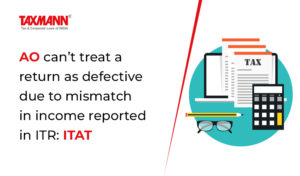AO can’t treat a return as defective due to mismatch in income reported in ITR: ITAT
- Blog|News|Income Tax|
- 2 Min Read
- By Taxmann
- |
- Last Updated on 18 May, 2022

Case Details: Deere & Company v. DCIT (International Transaction) - [2022] 138 taxmann.com 46 (Pune-Trib.)
Judiciary and Counsel Details
-
- R.S. Syal, Vice President & S.S. Viswanethra Ravi, Judicial Member
- Nikhil Mutha for the Appellant. Smt. Divya Bajpai for the Respondent.
Facts of the Case
Assessee-foreign company filed a return declaring total income consisting of income from royalty and fees for technical services. The return was processed by the Centralized Processing Centre (CPC), which highlighted the difference between the income shown in the return and as shown in Form No. 26AS.
Later, it declared the return to be invalid by means of the order under section 139(9). Appeal against such an order before the Commissioner (Appeals) came to be dismissed on the ground that the order under section 139(9) was not appealable under section 246A. Aggrieved-assessee filed the instant appeal before the Tribunal.
ITAT Held
The Tribunal held that as per sub-clause (vi) to section 143(1)(a), if a certain amount of income appearing in Form 26AS, etc., is not fully or partly included in the total income returned by the assessee, then the Assessing Officer (AO) will process the return and make the adjustment by way of addition to the total income so computed by the assessee.
Further, the two provisos to sub-clause (vi) of section 143(1)(a) also provide that AO is required to increase the total income computed by the assessee in its return with the differential higher income as appearing in Form 26AS. However, this can be done only after giving prior intimation to the assessee about such proposed adjustment and that too, after considering the response of the assessee.
However, in the instant case, AO had invoked Explanation (a) to section 139(9) on account of mismatch of the figures of income as returned and as per Form 26AS.
A cursory glance at the Explanation (a) to Section 139(9) manifests if all the annexures, statements, columns, etc., of the return, have been duly filled in, there can be no defect. The defect referred to here is non-filling of the requisite columns of the return of income and not filling of columns but non-tallying of the figures due to a valid difference of opinion.
If the Legislature had intended to treat the mismatch of income between Form 26AS and as shown in the return of income rendering the return defective, then there was no need to incorporate clause (vi) of section 143(1)(a) requiring the AO to carry out the adjustment during the processing of return of income on this score.
Further, if a subject is covered under a specific provision, then it cannot be included in any general provision. Thus, since clause (vi) of section 143(1)(a) specially covers a situation of mismatch in the amount of income returned and as appearing in Form 26AS requiring the making of an adjustment, the same subject matter cannot be covered within the purview of Explanation (a) to section 139(9) to render a return defective.
Disclaimer: The content/information published on the website is only for general information of the user and shall not be construed as legal advice. While the Taxmann has exercised reasonable efforts to ensure the veracity of information/content published, Taxmann shall be under no liability in any manner whatsoever for incorrect information, if any.

Taxmann Publications has a dedicated in-house Research & Editorial Team. This team consists of a team of Chartered Accountants, Company Secretaries, and Lawyers. This team works under the guidance and supervision of editor-in-chief Mr Rakesh Bhargava.
The Research and Editorial Team is responsible for developing reliable and accurate content for the readers. The team follows the six-sigma approach to achieve the benchmark of zero error in its publications and research platforms. The team ensures that the following publication guidelines are thoroughly followed while developing the content:
- The statutory material is obtained only from the authorized and reliable sources
- All the latest developments in the judicial and legislative fields are covered
- Prepare the analytical write-ups on current, controversial, and important issues to help the readers to understand the concept and its implications
- Every content published by Taxmann is complete, accurate and lucid
- All evidence-based statements are supported with proper reference to Section, Circular No., Notification No. or citations
- The golden rules of grammar, style and consistency are thoroughly followed
- Font and size that’s easy to read and remain consistent across all imprint and digital publications are applied



 CA | CS | CMA
CA | CS | CMA
